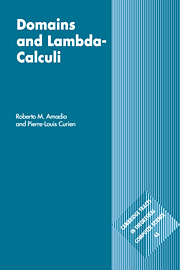Book contents
- Frontmatter
- Contents
- Preface
- Notation
- 1 Continuity and computability
- 2 Syntactic theory of the λ-calculus
- 3 D∞ models and intersection types
- 4 Interpretation of λ-calculi in CCC's
- 5 CCC's of algebraic dcpo's
- 6 The Language PCF
- 7 Domain equations
- 8 Values and computations
- 9 Powerdomains
- 10 Stone duality
- 11 Dependent and second order types
- 12 Stability
- 13 Towards linear logic
- 14 Sequentially
- 15 Domains and realizability
- 16 Functions and processes
- Appendix 1 Summary of recursion theory
- Appendix 2 Summary of category theory
- References and bibliography
- Index
13 - Towards linear logic
Published online by Cambridge University Press: 05 November 2011
- Frontmatter
- Contents
- Preface
- Notation
- 1 Continuity and computability
- 2 Syntactic theory of the λ-calculus
- 3 D∞ models and intersection types
- 4 Interpretation of λ-calculi in CCC's
- 5 CCC's of algebraic dcpo's
- 6 The Language PCF
- 7 Domain equations
- 8 Values and computations
- 9 Powerdomains
- 10 Stone duality
- 11 Dependent and second order types
- 12 Stability
- 13 Towards linear logic
- 14 Sequentially
- 15 Domains and realizability
- 16 Functions and processes
- Appendix 1 Summary of recursion theory
- Appendix 2 Summary of category theory
- References and bibliography
- Index
Summary
Girard's linear logic [Gir87] is an extension of propositional logic with new connectives providing a logical treatment of resource control. As a first hint, consider the linear λ-terms, which are the λ-terms defined with the following restriction: when an abstraction λx.M is formed, then x occurs exactly once in M. Linear λ-terms are normalized in linear time, that is, the number of reduction steps to their normal form is proportional to their size: a linear β-redex (λx.M)N involves no duplication of the argument N. Thus all the complexity of normalization comes from non-linearity.
Linear logic pushes the limits of constructivity much beyond intuitionistic logic. A proper proof theoretical introduction to linear logic is beyond the scope of this book. In this chapter, we content ourselves with a semantic introduction. By doing so, we actually follow the historical thread: the connectives of linear logic arose from the consideration of (a particularly simple version of) the stable model.
In section 13.1, we examine stable functions between coherence spaces, and discover two decompositions. First the function space E → E′ is isomorphic to a space (!E)⊸E′, where ⊸ constructs the space of linear functions, and where! is a constructor which allows reuse of data. Intuitively, linear functions, like linear terms, can use their input only once. On the other hand, the explicit declaration of reusability,!, allows us to recover all functions and terms.
- Type
- Chapter
- Information
- Domains and Lambda-Calculi , pp. 301 - 340Publisher: Cambridge University PressPrint publication year: 1998



